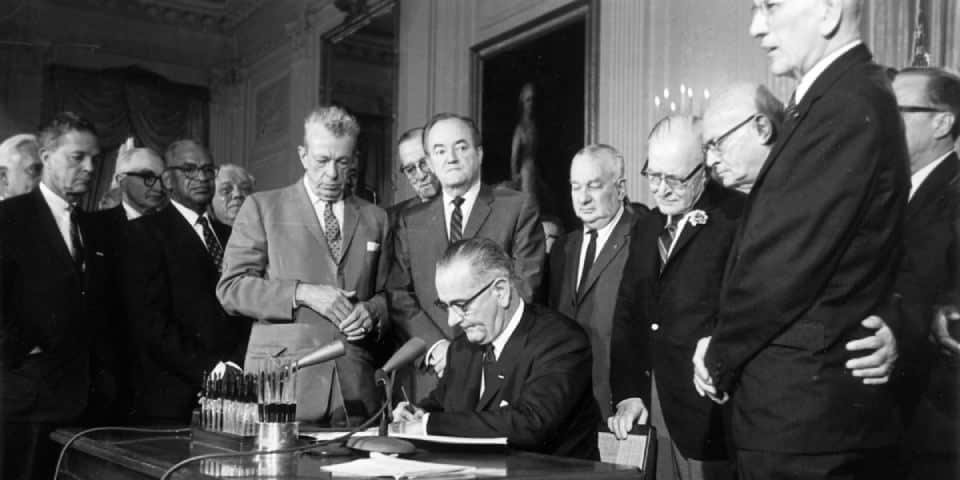Updated February 21, 2025
What is Executive Order 11246?
Executive Order 11246 is a U.S. federal order issued on September 24, 1965, aimed at promoting equal employment opportunities and prohibiting discrimination in the workplace by federal contractors and subcontractors. The order is a key component of efforts to ensure nondiscrimination and affirmative action in employment practices.
Key Provisions of Executive Order 11246:
Prohibition of Discrimination:
It prohibits federal contractors and subcontractors from discriminating against employees or job applicants based on race, color, religion, sex, sexual orientation, gender identity, or national origin.
Affirmative Action Requirements:
- Federal contractors are required to take affirmative action to ensure equal opportunity in all aspects of employment, including hiring, promotion, and training.
- This includes creating and maintaining affirmative action programs (AAPs) to address underrepresentation of certain groups.
Coverage:
- The order applies to federal contractors and subcontractors who have contracts exceeding $10,000 in a year.
- It also applies to construction contractors and subcontractors working on federally assisted projects.
Enforcement:
The Office of Federal Contract Compliance Programs (OFCCP), part of the U.S. Department of Labor, is responsible for enforcing Executive Order 11246. The OFCCP conducts compliance reviews and investigations to ensure contractors meet their obligations.
Amendments and Expansions:
Over time, the order has been amended to expand its protections:
- In 1967, it was amended to include sex as a protected category.
- In 2014, President Obama issued Executive Order 13672, which added protections for sexual orientation and gender identity.
Trump Revokes Executive Order 11246
On January 21, 2025, President Trump issued an executive order titled, “Ending Illegal Discrimination and Restoring Merit-Based Opportunity.”, revoking the primary cornerstone of workplace anti-discrimination efforts for nearly six decades. This action marks a significant shift in federal policy regarding diversity, equity, and inclusion (DEI) initiatives, with far-reaching implications for both government agencies and private sector contractors.
Executive Order 11246, which had stood as a bulwark against workplace discrimination for generations, required federal contractors to take affirmative action to ensure equal opportunity in their employment practices.
Details of Trump’s Revocation Order
The order is targeted at what the president describes as “illegal” diversity, equity, inclusion, and accessibility policies that:
. . . not only violate the text and spirit of our longstanding Federal civil-rights laws, they also undermine our national unity, as they deny, discredit, and undermine the traditional American values of hard work, excellence, and individual achievement in favor of an unlawful, corrosive, and pernicious identity-based spoils system.
The order declares that it is the policy of the United States:
to protect the civil rights of all Americans and to promote individual initiative, excellence, and hard work. I therefore order all executive departments and agencies (agencies) to terminate all discriminatory and illegal preferences, mandates, policies, programs, activities, guidance, regulations, enforcement actions, consent orders, and requirements. I further order all agencies to enforce our longstanding civil-rights laws and to combat illegal private-sector DEI preferences, mandates, policies, programs, and activities.
As part of this order, Executive Order 11246 is revoked and the agency within the U.S. Department of Labor that is responsible for implementing EO 11246 is required to immediately cease:
- (A) Promoting “diversity”;
- (B) Holding Federal contractors and subcontractors responsible for taking “affirmative action”; and
- (C) Allowing or encouraging Federal contractors and subcontractors to engage in workforce balancing based on race, color, sex, sexual preference, religion, or national origin.
Historical Significance of Executive Order 11246
Executive Order 11246 has been a pillar of civil rights legislation since its inception in the mid-1960s. Originally signed by President Lyndon B. Johnson in 1965, during a period of significant social upheaval and progress in the fight for equality, this order represented a watershed moment in the federal government’s approach to workplace discrimination.
Origins and Context
The order emerged from the crucible of the Civil Rights Movement, a time when the nation was grappling with deeply entrenched racial inequalities. President Johnson, building on the momentum of the Civil Rights Act of 1964, sought to leverage the federal government’s contracting power to promote equal opportunity in the workplace.
Key Provisions
At its core, Executive Order 11246 prohibited federal contractors from discriminating against employees or applicants based on race, color, religion, sex, or national origin. It went beyond mere prohibition, however, by requiring contractors to take proactive steps—affirmative action—to ensure fair treatment and representation of historically marginalized groups.
Impact Over Time
Over the decades, the order has been instrumental in opening doors for minorities and women in various industries. It has served as a model for similar policies in state and local governments and has influenced corporate diversity initiatives nationwide.
Amendments and Expansions
Since its original signing, the order has been amended several times to broaden its scope. Notable expansions included protections based on sexual orientation and gender identity, reflecting evolving societal norms and understanding of discrimination.
Trump Administration’s Rationale for Revocation
The Trump administration’s decision to revoke Executive Order 11246 stems from a fundamentally different perspective on the role of government in promoting workplace diversity and combating discrimination. This section examines the key arguments put forth by the administration to justify this significant policy shift.
Critique of DEI Programs
Central to the administration’s rationale is a critique of diversity, equity, and inclusion (DEI) programs. Officials have characterized these initiatives as divisive, arguing that they promote a form of reverse discrimination and undermine the principle of merit-based advancement.
Emphasis on "Colorblind" Policies
The administration has advocated for what it terms a "colorblind" approach to hiring and promotion. This philosophy contends that the best way to achieve fairness is to remove all considerations of race, gender, and other protected characteristics from employment decisions.
Claims of Ineffectiveness
Another argument presented is that after decades of implementation, affirmative action policies have not achieved their intended goals. The administration suggests that these programs may have outlived their usefulness in the modern workplace.
Legal Concerns
There are also legal arguments being made, with some officials claiming that certain aspects of affirmative action and DEI programs may actually violate civil rights laws by favoring some groups over others.
Immediate Actions and Directives
In the wake of revoking Executive Order 11246, the Trump administration has issued a series of directives aimed at rapidly dismantling diversity and inclusion efforts across the federal government. These actions represent a dramatic shift in policy and have immediate consequences for thousands of federal employees and contractors.
Placement of DEI Staff on Administrative Leave
One of the most immediate and visible actions has been the directive to place all federal employees working on diversity, equity, and inclusion initiatives on administrative leave. This sudden move has effectively halted ongoing DEI efforts across government agencies.
Shutdown of DEI Offices and Programs
Alongside the staff furloughs, the administration has ordered the closure of DEI offices and the termination of related programs. Agencies have been given tight deadlines to compile lists of affected offices and employees, with plans for permanent layoffs to follow.
Revision of Hiring and Promotion Practices
Federal agencies have been instructed to revise their hiring and promotion practices to eliminate any consideration of diversity-related factors. The focus is to be shifted entirely to what the administration terms "merit-based" criteria.
Reporting Requirements
A system has been established requiring federal employees to report any colleagues who may be attempting to continue DEI efforts covertly. This has created an atmosphere of uncertainty and potential conflict within many agencies.
Impact on Federal Contractors
The revocation of Executive Order 11246 has significant implications for companies that do business with the federal government. These contractors, who have long operated under specific requirements to promote diversity and prevent discrimination, now face a rapidly changing landscape.
Elimination of Affirmative Action Requirements
Federal contractors are no longer required to maintain affirmative action programs or set diversity-related goals in their hiring and promotion practices. This represents a fundamental shift in how these companies approach workforce diversity.
Changes to Compliance Monitoring
The Office of Federal Contract Compliance Programs (OFCCP), which previously monitored contractors for adherence to equal opportunity standards, will likely see its role significantly diminished or altered.
Potential for Increased Discrimination Claims
With the removal of proactive diversity measures, there is concern among civil rights advocates that incidents of workplace discrimination may increase, potentially leading to a rise in legal claims against contractors.
Adaptation of Corporate Policies
Many contractors are now in the process of reevaluating and potentially overhauling their internal diversity and inclusion policies to align with the new federal stance while also considering their own corporate values and stakeholder expectations.
Reactions from Civil Rights Organizations
The decision to revoke Executive Order 11246 has elicited strong responses from civil rights organizations across the country. These groups, many of which have long championed affirmative action and equal opportunity initiatives, have been vocal in their opposition to the administration’s actions.
Statements of Condemnation
Prominent civil rights organizations have issued forceful statements condemning the revocation, characterizing it as a significant setback in the fight against workplace discrimination and systemic inequality.
Legal Challenges
Several organizations have announced plans to challenge the administration’s actions in court, arguing that the revocation violates existing civil rights laws and constitutional protections.
Mobilization of Supporters
Civil rights groups are actively mobilizing their supporters, calling for protests, letter-writing campaigns, and other forms of civic engagement to oppose the policy change.
Alternative Strategies
In light of the federal policy shift, some organizations are developing alternative strategies to promote diversity and inclusion in the workplace, focusing on private sector initiatives and state-level policies.
Congressional Response
The revocation of Executive Order 11246 has prompted varied reactions from members of Congress, reflecting the deep political divisions on issues of affirmative action and workplace diversity. This section examines the legislative branch’s response to the administration’s actions.
Partisan Divide
The congressional response has largely fallen along party lines, with Democrats condemning the move and Republicans generally supporting the administration’s decision.
Proposed Legislation
Some members of Congress have begun drafting legislation aimed at codifying elements of the revoked executive order into law, while others are working on bills to support the administration’s new direction.
Oversight Hearings
Congressional committees have announced plans to hold oversight hearings to examine the impact of the revocation on federal agencies and contractors.
Budget Implications
Discussions have begun regarding potential changes to agency budgets, particularly concerning funds previously allocated to diversity and inclusion programs.
Legal Challenges and Potential Court Battles
The revocation of Executive Order 11246 is likely to face significant legal challenges, setting the stage for potentially lengthy court battles that could shape the future of equal employment opportunity law in the United States.
Constitutional Questions
Legal experts are debating whether the revocation of the order violates constitutional protections against discrimination, particularly in light of previous Supreme Court rulings on affirmative action.
Statutory Interpretation
Courts may be called upon to interpret how the revocation interacts with existing civil rights statutes, such as Title VII of the Civil Rights Act of 1964.
Standing and Jurisdiction
A key legal question will be determining who has standing to challenge the revocation and in which courts these challenges can be heard.
Potential for Supreme Court Involvement
Given the significance of the issue, there is speculation that cases related to the revocation could eventually make their way to the Supreme Court, potentially leading to landmark decisions on affirmative action and equal opportunity.
Economic and Business Implications
The revocation of Executive Order 11246 has far-reaching implications for the American economy and business landscape. This section explores how this policy shift may impact various sectors and overall economic trends.
Labor Market Dynamics
Economists are debating how the removal of affirmative action requirements might affect hiring patterns and workforce demographics across industries.
Corporate Diversity Initiatives
Many large corporations have invested heavily in diversity and inclusion programs. The federal policy change may influence how these companies approach such initiatives moving forward.
Small Business Impact
Small businesses that contract with the federal government may face challenges in adapting to the new regulatory environment, particularly if they have relied on government guidance for their diversity efforts.
Innovation and Competitiveness
There is ongoing discussion about how changes in workforce diversity might impact innovation and global competitiveness in various industries.
International Perspectives and Comparisons
The United States’ shift away from federally mandated affirmative action policies has drawn attention from the international community. This section examines how this decision is viewed globally and compares it to diversity policies in other countries.
Reactions from Allies
Many of America’s traditional allies, particularly in Europe, have expressed concern about the revocation, viewing it as a step backward in the fight against discrimination.
Comparisons with Other Nations
Analysis of how other developed nations approach workplace diversity and anti-discrimination efforts provides context for understanding the global implications of this policy change.
Impact on Multinational Corporations
Companies operating in multiple countries may face challenges in reconciling the new U.S. policy with diversity requirements in other jurisdictions.
Human Rights Considerations
International human rights organizations have weighed in on the decision, often framing it within the context of global efforts to combat discrimination and promote equality.
Future of Diversity and Inclusion in the Workplace
As the dust settles on the revocation of Executive Order 11246, questions arise about the future of diversity and inclusion initiatives in American workplaces. This section explores potential scenarios and emerging trends in this evolving landscape.
Private Sector Leadership
With the federal government stepping back from mandating diversity efforts, there may be increased pressure on private companies to take the lead in promoting workplace inclusion.
State and Local Initiatives
In the absence of federal requirements, state and local governments may step in to fill the void, potentially leading to a patchwork of diversity policies across the country.
Technological Solutions
Some companies are exploring the use of AI and other technologies to promote unbiased hiring and promotion practices, potentially offering new approaches to workplace diversity.
Evolving Definitions of Diversity
The conversation around workplace diversity may shift to include a broader range of factors beyond race and gender, such as socioeconomic background, neurodiversity, and other dimensions of human difference.
Conclusion
The revocation of Executive Order 11246 marks a significant turning point in the history of equal employment opportunity in the United States. This decision has far-reaching implications for federal agencies, government contractors, and the broader American workforce. As legal challenges unfold and businesses adapt to the new landscape, the debate over the most effective ways to promote workplace diversity and combat discrimination is likely to intensify.
The coming months and years will be crucial in determining the long-term impact of this policy shift. Will it lead to a more merit-based system as proponents argue, or will it roll back decades of progress in workplace equality as critics fear? The answers to these questions will shape the American workplace for generations to come.
It is uncertain at this time what actions Governor Gavin Newsom will pursue to protect California workers from Trump’s executive order.





